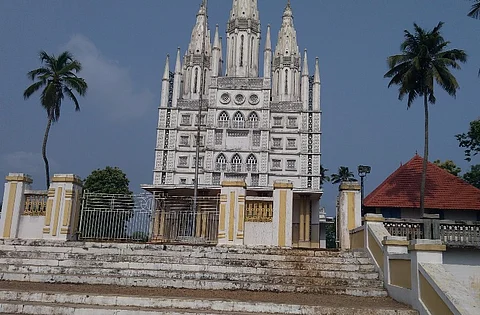

For half a century now, Kerala has been witnessing a fight between two factions of Malankara Christians, in the Kerala Malankara Orthodox Church and Jacobite Syrian Christian church. Finally, the battle seems to have concluded, thanks to a Supreme Court Order on July 3.
And now, the Jacobite Syrian church of Kerala cannot be a part of the Malankara group any longer: They will either have to become an independent church, or disband and join the Orthodox church.
History
To understand the fight, we need to go back to the year 1599, when a diocese council meet called the Synod of Diamper was held at Udayamperoor in Ernakulam district. The Synod laid down rules and regulations for the Saint Thomas Christians of the Malabar Coast (Kerala) and formally united them with the Catholic Church.
However, the orthodox Malankara Christians separated from the other Christian churches of Kerala that came under the Pope in Rome. The group declared that they would following Patriarch of Antioch, instead of the Pope in Rome.
By 1910, the Malankaras split again, and two more factions were formed: One group supported the Patriarch of Antioch, and were called the Bava Kakshi (now the Jacobite Syrian church), and the second faction supported their own Bishop based in Kottayam, and they were called the Methran Kakshi (the Kerala Malankara Orthodox church).
That was the real start of the battle between the two factions, but until 1934, the conflict was largely peaceful.
The crucial 1934 agreement
In 1934, the two factions temporarily came together to elect a bishop, Baselious Geevarghese Catholica, in Kottayam.
The election followed an agreement. “That was actually a wise agreement prepared by the Orthodox Christians, who did not want to come under the Patriarch of Antioch anymore. They believed that the power should rest with their bishop in Kottayam, but they wisely added that they will continue to be ‘in support of’ the Patriarch of Antioch,” says Jins Nalleparampan, Joint Convenor at Christian Helpline, an organisation for the welfare of Christians.
“The support in no way meant that the Malankaras were under the Patriarch of Antioch, or that the Patriarch had temporal authority over the church in Kerala. And somehow, the Jacobites who supported the Patriarch of Antioch signed the agreement back then,” Jins explains.

Kolencherry Church
The 1974 split
In 1970, the merged factions peacefully elected a Bishop together. But after 1970, things turned sour as the Patriarch of Antioch started involving himself in the daily affairs of the Church in Kerala,” Jins says.
In 1974, he anointed three bishops in Kerala himself, and this triggered off another round of conflict.
“This created a huge issue in Kerala, and the two factions fought each other on the streets. They started capturing churches which belonged to both of them for all those centuries,” Jins says.
The case reaches court
In 1995 the case reached Supreme Court, and the court ruled that the 1934 agreement will stand - which was in favour of the Orthodox church.
In 2002 the faction which supported the Patriarch of Antioch gathered together in Puthen Cruz of Ernakulam district and named themselves Jacobite Syrian Christians, and also formed a manifesto for themselves.
In many churches owned by the group, largescale violence occurred. The two factions fought for authority, with the Orthodox church being headquartered at Devalokam in Kottayam, and the Jacobite church headquartered in Puthen Cruz.
“The battle continued for years; protests took place outside the churches even when prayers were going on. Many of the churches were closed down. Kolencherry church was closed for years. Whenever the Orthodox group tried to open it, the Jacobites created issues. Even when particular mass timings were given for both factions separately, it did not work out,” Jins recounts.
The latest verdict
Finally the issue reached the Supreme Court once again. And once again, the court ruled that the 1934 agreement will hold.
The bench consisting Justice Arun Misra and Justice Amitava Roy, ruled that in this issue, only the 1934 agreement will be considered, and that the 2002 manifesto made by Jacobites was not legal.
SC mentioned that the 1934 agreement will be applicable to all the parishes and the diocese.
So as per the 1934 rule, the complete power rests in the hands of the Orthodox faction and their bishops.
Though the case was regarding the churches of Kolecherry, Mannathur and Vaarikkoli, this ruling would be effective for all the Jacobite/Orthodox churches in Kerala.
So, in that case, the Jacobite Syrian Church cannot practically remain separate.
“Technically, Jacobites cannot exist in the Malankara church, although they can remain an independent church like the Pentecost church. But they can’t remain with the Malankara group. The other option is for all the Jacobite priests and other leaders to join the Orthodox church,” Jins says.
However, Jacobite groups have not yet decided whether to join the Orthodox church, or to build new churches. They have informed that they will once again approach the SC seeking clarity in its order.
However, it will not affect the believers, as both the factions follow the same religious rites of worship, and their churches will continue to organise prayers as usual.
Edited by Ragamalika Karthikeyan